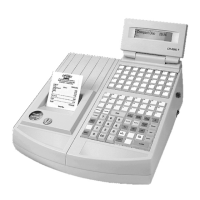7
1.3 General Precautions
• In case of malfunction do not repair the Cash Register by yourself. Please contact your
nearest dealer or sales person.
• Do not insert any metal objects such as screwdriver, paper clips etc. into your Cash
Register. This may damage your Cash Register or subject you to electrical shocks.
• Clean your Cash Register from time to time with a soft, dry or slightly damp cloth.
• Never use water or any volatile chemicals, such as benzene for cleaning. This may
damage your Cash Register.
1.4 Printer Precautions
• Never use the printer without a ribbon or without paper rolls.
• Do not pull the paper out during the printing process.
• Only use good quality paper free of wood pulp.
• Do not to attempt to move gears or the printing head by hand or with a screwdriver.
• Immediately install new paper rolls when ”paper-near-end” is indicated.
• Change the cassette ribbon as soon as the print becomes faint.
• Thermal sensitive paper is necessary for thermal printers. The thermal paper has to
weigh between 55 gr. and 72 gr. and have a thickness of 65 µm to 125 µm. Good print
quality will be achieved with middle sensitivity.
1.5 Setting up the Cash Register
• Make sure the local voltage corresponds with the voltage indications on the serial
number plate of your Cash Register.
• To assure a proper charge of the protection circuit, it is recommended that the Cash
Register is recharged several hours prior to use.
• Place the Cash Register conveniently close to a standard wall outlet.
2. Installing the Cash Register
• Plug your Cash Register into a standard electrical wall outlet with the ON/OFF switch in
OFF position.
• Activate the power ON/OFF switch to power up your Cash Register.
• Insert the OWP key into the control lock and turn it to position ”T” (train mode).
• Install the ribbon cassette and paper rolls. Follow the instructions on page 7.
• You can now use the Cash Register for simulated operations without affecting the
memory.

